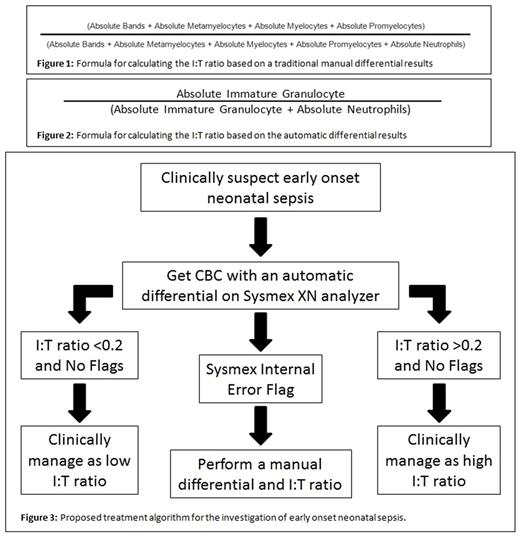Abstract
Background: Early onset neonatal sepsis is a difficult diagnosis to confirm and current practice guidelines rely heavily on the presence of risk factors and the clinician's index of suspicion1. Unfortunately, there are no laboratory tests with a strong predictive value. At our two regional institutions, newborns that are at high risk for neonatal sepsis are assessed with a CBC and the calculation of the immature to total neutrophils (I:T ratio). This calculation requires a differential count to be performed, which takes an average of 4 hours. If the results are normal, the neonate may be discharged home. In Hamilton, approximately 7,000 children are born annually, with about 1,300 of them investigated for sepsis.
Our newly implemented Sysmex hematology analyzers have the ability to perform a cell count and result the absolute immature granulocyte count and absolute neutrophil count with the CBC results - these results are available at the same time as the CBC.
Objective: To compare the predictive value of the calculated I:T ratio from automatic and manually counted CBC differentials in neonates with suspected early sepsis.
Methods: A retrospective review of the first blood draws within the 24 hours of life on newborns being investigated for early onset sepsis over a period of 7 months at two teaching hospitals. All samples had a 100 cell count differential performed on the Cellavision as well as an automatic 32,000 cell count differential performed using the Sysmex XN series analyzers. The I:T ratio was then calculated based on the results from methods (Figure 1 and 2).
Results are clinically concerning when the calculated I:T ratio is >0.2. We considered results to be discordant when only one of the two manual or automatic immature cell counts was >0.2.
Results: 768 newborns were investigated for possible sepsis during this time period. 7.7% of these patients had an elevated I:T ratio calculation based on the traditional 100 cell count manual differential.
The I:T calculation with the automatic results correlated with the manual in 93.2% of cases. Of the discordant 52 cases, Sysmex produced internal error flags which would trigger a manual differential to be performed and reviewed in 50 cases. A repeated manual differential reported a normal I:T ratio for one of these cases; thus only 1 of the 768 assessed samples was truly discordant.
Conclusions: We found a high correlation between manual and automatic counts; in cases of discordant counts a manual count was automatically generated based on error flagging criteria. Based on our results, we are proposing an algorithm for the investigation of early onset neonatal sepsis (Figure 3).
Automatic cell counts are able to correctly identify the majority of neonates with a high I:T ratio. This algorithm will reduce manual differential rates in this population by up to 93%, reducing up to 4 hours from the "usual care" of these patients.
References:
1. Jefferies, A. L. Management of term infants at increased risk for early onset bacterial sepsis. Canadian Pediatrics Society. 2017. Position Statement.
2. Murphy K, Weiner J. Use of leukocyte counts in evaluation of early-onset neonatal sepsis. Pediatr Infect Dis J. 2012;31:16-19.
Crowther: Portola: Consultancy; Pfizer: Honoraria; Leo Pharma: Research Funding; Boehringer Ingelheim: Speakers Bureau; Bayer: Membership on an entity's Board of Directors or advisory committees, Research Funding, Speakers Bureau; Alexion: Speakers Bureau; Shinogi: Consultancy.
Author notes
Asterisk with author names denotes non-ASH members.


